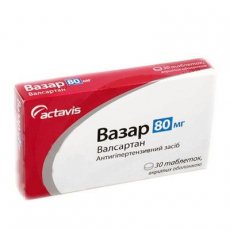Medical expert of the article
New publications
Preparations
Vazar
Last reviewed: 03.07.2025

All iLive content is medically reviewed or fact checked to ensure as much factual accuracy as possible.
We have strict sourcing guidelines and only link to reputable media sites, academic research institutions and, whenever possible, medically peer reviewed studies. Note that the numbers in parentheses ([1], [2], etc.) are clickable links to these studies.
If you feel that any of our content is inaccurate, out-of-date, or otherwise questionable, please select it and press Ctrl + Enter.

Vazar should be classified as a medication that stabilizes blood pressure. The active component of this drug is valsartan, an effective angiotensin II receptor blocker.
Release form
Vazan is produced in tablet form, intended for internal use. The coated tablets can have different dosages and colors: 0.04 g - yellow, 0.08 g - pink, and 0.16 g - also yellow.
Vazan consists of the active component valsartan and a smaller amount of hydrochlorothiazide. The excipients are lactose, MCC, croscarmellose, magnesium stearate, etc.
Pharmacodynamics
The active component of the drug is a specific angiotensin II antagonist. It selectively affects a number of AT¹ receptors responsible for the performance of angiotensin II functions.
AT¹ receptors are blocked, the level of antitensin in the blood serum increases, which helps to activate AT² receptors that remain unblocked.
The active component is not able to inhibit ACE, nor to interact with and block other types of hormonal receptors and ion channels that may be important for the normal functioning of the cardiovascular system.
The drug does not affect the amount of cholesterol in the bloodstream.
Pharmacokinetics
The ability of Vazar to reduce blood pressure is already evident within the first two hours. The maximum effect can be observed within 5 hours after a single use of the drug. The effect of Vazar is maintained for 24 hours.
With long-term treatment, the maximum effect is observed within 3 weeks, which then remains unchanged throughout the entire therapeutic course.
The drug owes its enhanced blood pressure lowering effect to hydrochlorothiazide, which is part of the drug.
Completion of the treatment course usually does not entail withdrawal syndrome. When an additional course of treatment is prescribed, a slight accumulation may be observed.
The active substances of the drug are quickly absorbed, the biological availability of the substances is determined at 23%. They bind to blood serum proteins.
After oral administration, about 83% of the drug is excreted unchanged in the feces, and about 13% through the urinary system.
Dosing and administration
The usual therapeutic dosage of Vazar for signs of hypertension may be 0.16 g once a day. The dosage may be adjusted by the doctor to 0.32 g per day, if there are appropriate indications. Combined treatment regimens with the use of other drugs with similar action are possible.
The starting dose for chronic forms of cardiac failure may be 0.04 g twice a day, with a gradual increase in the dose to 0.16 g twice a day.
The starting dose after myocardial infarction may be 0.02 g twice daily, with a gradual increase in dosage to 0.16 g twice daily.
The use of the drug in children and adolescents has not been studied.
Use Vazar during pregnancy
The drug Vazar is not used by pregnant women.
Breastfeeding is also a contraindication for prescribing this drug.
Contraindications
The use of the drug Vazar is contraindicated:
- if you are prone to an allergic reaction to any of the components of the medication;
- in case of serious liver pathologies;
- in case of fatty liver disease;
- in case of obstruction of the bile ducts, calculous cholecystitis;
- in case of renal dysfunction;
- during pregnancy;
- during hemodialysis procedure.
Side effects Vazar
Adverse effects of the drug include:
- orthostatic hypotension;
- infectious lesion of the nasal sinuses (various types of sinusitis, pharyngitis);
- the appearance of conjunctivitis;
- cardiac disorders;
- dyspeptic manifestations;
- spinal pain;
- muscle and joint pain;
- cough;
- depressive states;
- sleep disturbances, apathy, nervousness;
- nosebleed;
- deterioration of the urinary and digestive systems.
Overdose
A sign of overdose may be the development of a hypotensive state, accompanied by dizziness, headaches, and nausea. In such a situation, the patient must be provided with a lying position and rest. Drip administration of saline solutions is indicated.
The use of dialysis in case of an overdose of Vazar is not considered advisable, since the substances of the drug are bound in large quantities by blood serum proteins.
Interactions with other drugs
The simultaneous use of potassium-rich drugs (antiarrhythmic drugs, potassium-sparing diuretics, vitamin complexes) may require caution and periodic monitoring of potassium levels in the body.
The use of other diuretics and blood pressure lowering drugs does not form cross-interactions with Vazar. In some cases, such drugs only potentiate the effect of valsartan.
The use of nonsteroidal anti-inflammatory drugs may reduce the hypotensive effect and temporarily impair renal function. After discontinuing the drugs, urinary function usually recovers.
The drug enhances the effect of curare-like relaxants.
The risk of hypokalemia increases with the combined use of corticosteroids, penicillin derivatives, saluretic drugs, and salicylates.
Storage conditions
The medicine Vazar should be stored at a temperature of 22-24°C, in a dark place, out of the reach of children.
 [ 32 ]
[ 32 ]
Shelf life
Shelf life: up to 2 years.
Attention!
To simplify the perception of information, this instruction for use of the drug "Vazar" translated and presented in a special form on the basis of the official instructions for medical use of the drug. Before use read the annotation that came directly to medicines.
Description provided for informational purposes and is not a guide to self-healing. The need for this drug, the purpose of the treatment regimen, methods and dose of the drug is determined solely by the attending physician. Self-medication is dangerous for your health.

